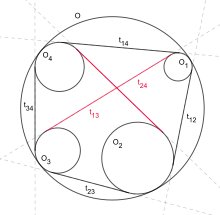Casey teoremi
Matematikte, genelleştirilmiş Batlamyus teoremi olarak da bilinen Casey teoremi, adını İrlandalı matematikçi John Casey[1]'den alan Öklid geometrisindeki bir teoremdir.
Teoremin formülasyonu

, yarıçapı olan bir çember olsun. (sırasıyla) içinde yer alan kesişmeyen ve 'ya teğet olan dört çember olsun. , çemberlerin dış ortak çifte teğet (bitanjant)'inin uzunluğunu göstersin. Buna göre: [2]
- .
Dört çemberin hepsinin noktalara indirgendiği dejenere durumda, bunun tam olarak Batlamyus teoremi olduğuna dikkat edin.
İspat
Aşağıdaki kanıt Zacharias[3]'a atfedilebilir[4]. çemberinin yarıçapını ile belirtelim ve çember ile teğet noktasını da ile gösterelim. Çemberlerinin merkezleri için gösterimini kullanacağız. Pisagor teoreminden,
Bu uzunluğu, türünden ifade etmeye çalışacağız . üçgende kosinüs yasasına göre,
çemberleri birbirine teğet olduğundan:
, çemberinin üzerindeki bir nokta olsun. üçgeninde sinüs yasasına göre:
Bu nedenle,
ve bunları yukarıdaki formülde yerine koyarsak:
Ve son olarak, aradığımız uzunluk;
kirişler dörtgenine uygulanan orijinal Batlamyus teoreminin yardımıyla artık sol tarafı hesaplayabiliriz:
Diğer genellemeler
Görülebileceği gibi, dört çemberin büyük çemberin içinde olması gerekmiyor. Aslında, ona dışarıdan da teğet olabilirler. Bu durumda aşağıdaki değişiklik yapılmalıdır: [5]
Eğer , ikisi de 'nun aynı tarafından teğetse (her ikisi de içeriden veya her ikisi de dışarıdan), dış ortak teğetin uzunluğudur.
Eğer , 'ya farklı yönlerden teğetse (biri içeriden ve biri dışarıdan), iç ortak teğetin uzunluğudur.
Casey teoreminin tersi de doğrudur.[5] Yani, eşitlik geçerliyse, çemberler ortak bir çembere teğettir.
Uygulamalar
Casey teoremi ve tersi, Öklid geometrisindeki çeşitli ifadeleri kanıtlamak için kullanılabilir. Örneğin, Feuerbach teoreminin bilinen en kısa kanıtı [2] :411 Casey teoreminin tersini kullanır.
Notlar
- O'Connor, John J.; Robertson, Edmund F., "John Casey", MacTutor History of Mathematics arşivi
- Casey (1866). "On the Equations and Properties: (1) of the System of Circles Touching Three Circles in a Plane; (2) of the System of Spheres Touching Four Spheres in Space; (3) of the System of Circles Touching Three Circles on a Sphere; (4) of the System of Conics Inscribed to a Conic, and Touching Three Inscribed Conics in a Plane". Proceedings of the Royal Irish Academy. 9: 396-423.
- Zacharias (1942). "Der Caseysche Satz". Jahresbericht der Deutschen Mathematiker-Vereinigung. 52: 79-89.
- Hoofdstukken uit de Elementaire Meetkunde. (translation by Reinie Erné as Topics in Elementary Geometry, Springer 2008, of the second extended edition published by Epsilon-Uitgaven 1987). 1944.
- Modern Geometry. Houghton Mifflin, Boston (republished facsimile by Dover 1960, 2007 as Advanced Euclidean Geometry). 1929.
Dış bağlantılar
- Eric W. Weisstein, Casey's theorem (MathWorld)
- Shailesh Shirali: On a generalized Ptolemy Theorem, ss. 49-53
- Crux Mathematicorum volume 22 issue 2 (yukarıdaki makaleyi içerir)
- Casey’s Theorem @cut-the-knot
- Casey’s Theorem @geogebra
İlave okumalar
- Luis Gonzalez. (2011), Casey’s Theorem and its Applications, Makale
- Kin Y. Li. (201), Casey’s Theorem, Makale
- Abrosimov, Nikolay & Mikaiylova, Liudmila. (2015). Casey's theorem in hyperbolic geometry. Siberian Electronic Mathematical Reports. 12. ss. 354-360. 10.17377/semi.2015.12.029.
- Abrosimov, N.V., Aseev, V.V. Generalizations of Casey’s Theorem for Higher Dimensions. Lobachevskii J Math 39, 1–12 (2018). https://doi.org/10.1134/S199508021801002X
- (Japonca) Y. Mikami, (1919), Casey's theorem in Japanese mathematics, Makale
Kaynakça
- Casey, J. (1866). "On the Equations and Properties: (1) of the System of Circles Touching Three Circles in a Plane; (2) of the System of Spheres Touching Four Spheres in Space; (3) of the System of Circles Touching Three Circles on a Sphere; (4) of the System of Conics Inscribed to a Conic, and Touching Three Inscribed Conics in a Plane". Proceedings of the Royal Irish Academy. 9: 396-423. JSTOR 20488927.
- Zacharias, M. (1942). "Der Caseysche Satz". Jahresbericht der Deutschen Mathematiker-Vereinigung. 52: 79-89.
- Bottema, O. (1944). Hoofdstukken uit de Elementaire Meetkunde. (translation by Reinie Erné as Topics in Elementary Geometry, Springer 2008, of the second extended edition published by Epsilon-Uitgaven 1987).
- Johnson, Roger A. (1929). Modern Geometry. Houghton Mifflin, Boston (republished facsimile by Dover 1960, 2007 as Advanced Euclidean Geometry).
